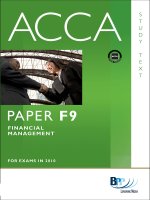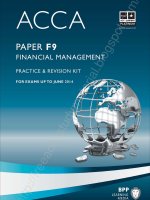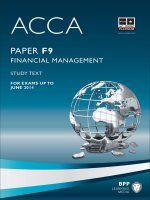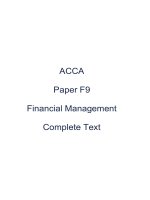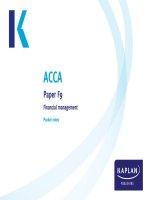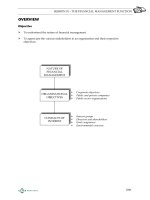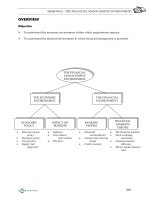Financial Management (F9) June & December 2012
Bạn đang xem bản rút gọn của tài liệu. Xem và tải ngay bản đầy đủ của tài liệu tại đây (126.73 KB, 13 trang )
Financial Management
(F9)
June & December 2012
This syllabus and study guide is designed to help
with planning study and to provide detailed
information on what could be assessed in
any examination session.
THE STRUCTURE OF THE SYLLABUS AND
STUDY GUIDE
Relational diagram of paper with other papers
This diagram shows direct and indirect links
between this paper and other papers preceding or
following it. Some papers are directly underpinned
by other papers such as Advanced Performance
Management by Performance Management. These
links are shown as solid line arrows. Other papers
only have indirect relationships with each other
such as links existing between the accounting and
auditing papers. The links between these are shown
as dotted line arrows. This diagram indicates where
you are expected to have underpinning knowledge
and where it would be useful to review previous
learning before undertaking study.
Overall aim of the syllabus
This explains briefly the overall objective of the
paper and indicates in the broadest sense the
capabilities to be developed within the paper.
Main capabilities
This paper’s aim is broken down into several main
capabilities which divide the syllabus and study
guide into discrete sections.
Relational diagram of the main capabilities
This diagram illustrates the flows and links between
the main capabilities (sections) of the syllabus and
should be used as an aid to planning teaching and
learning in a structured way.
Syllabus rationale
This is a narrative explaining how the syllabus is
structured and how the main capabilities are linked.
The rationale also explains in further detail what the
examination intends to assess and why.
Detailed syllabus
This shows the breakdown of the main capabilities
(sections) of the syllabus into subject areas. This is
the blueprint for the detailed study guide.
Approach to examining the syllabus
This section briefly explains the structure of the
examination and how it is assessed.
Study Guide
This is the main document that students, tuition
providers and publishers should use as the basis of
their studies, instruction and materials.
Examinations will be based on the detail of the
study guide which comprehensively identifies what
could be assessed in any examination session.
The study guide is a precise reflection and
breakdown of the syllabus. It is divided into sections
based on the main capabilities identified in the
syllabus. These sections are divided into subject
areas which relate to the sub-capabilities included
in the detailed syllabus. Subject areas are broken
down into sub-headings which describe the detailed
outcomes that could be assessed in examinations.
These outcomes are described using verbs
indicating what exams may require students to
demonstrate, and the broad intellectual level at
which these may need to be demonstrated
(*see intellectual levels below).
Learning Materials
ACCA's Approved Learning Partner - content (ALP-
c) is the programme through which ACCA approves
learning materials from high quality content
providers designed to support study towards ACCA’s
qualifications.
ACCA has one Platinum Approved Learning Partner
content which is BPP Learning Media. In addition,
there are a number of Gold Approved Learning
Partners - content.
1
© ACCA 2012 All rights reserved.
For information about ACCA's
Approved Learning Partners - content, please go
ACCA's Content Provider Directory.
The Directory also lists materials by Subscribers,
these materials have not been quality assured by
ACCA but may be helpful if used in conjunction with
approved learning materials. You will also
find details of Examiner suggested Additional
Reading which may be a useful supplement to
approved learning materials.
ACCA's Content Provider Directory can be found
here –
/>ontent_provider_directory/search/.
Relevant articles will also be published in Student
Accountant.
INTELLECTUAL LEVELS
The syllabus is designed to progressively broaden
and deepen the knowledge, skills and professional
values demonstrated by the student on their way
through the qualification.
The specific capabilities within the detailed
syllabuses and study guides are assessed at one of
three intellectual or cognitive levels:
Level 1: Knowledge and comprehension
Level 2: Application and analysis
Level 3: Synthesis and evaluation
Very broadly, these intellectual levels relate to the
three cognitive levels at which the Knowledge
module, the Skills module and the Professional level
are assessed.
Each subject area in the detailed study guide
included in this document is given a 1, 2, or
3 superscript, denoting intellectual level, marked at
the end of each relevant line. This gives an
indication of the intellectual depth at which an area
could be assessed within the examination. However,
while level 1 broadly equates with the Knowledge
module, level 2 equates to the Skills module and
level 3 to the Professional level, some lower level
skills can continue to be assessed as the student
progresses through each module and level. This
reflects that at each stage of study there will be a
requirement to broaden, as well as deepen
capabilities. It is also possible that occasionally
some higher level capabilities may be assessed at
lower levels.
LEARNING HOURS
The ACCA qualification does not prescribe or
recommend any particular number of learning hours
for examinations because study and learning
patterns and styles vary greatly between people and
organisations. This also recognises the wide
diversity of personal, professional and educational
circumstances in which ACCA students find
themselves.
Each syllabus contains between 23 and 35 main
subject area headings depending on the nature of
the subject and how these areas have been broken
down.
GUIDE TO EXAM STRUCTURE
The structure of examinations varies within and
between modules and levels.
The Fundamentals level examinations contain
100% compulsory questions to encourage
candidates to study across the breadth of each
syllabus.
The Knowledge module is assessed by equivalent
two-hour paper based and computer based
examinations.
The Skills module examinations are all paper based
three-hour papers. The structure of papers varies
from ten questions in the Corporate and Business
Law (F4) paper to four 25 mark questions in
Financial Management (F9). Individual questions
within all Skills module papers will attract between
10 and 30 marks.
The Professional level papers are all three-hour
paper based examinations, all containing two
sections. Section A is compulsory, but there will be
some choice offered in Section B.
For all three hour examination papers, ACCA has
introduced 15 minutes reading and planning time.
This additional time is allowed at the beginning of
each three-hour examination to allow candidates to
read the questions and to begin planning their
2
© ACCA 2012 All rights reserved.
answers before they start writing in their answer
books. This time should be used to ensure that all
the information and exam requirements are properly
read and understood.
During reading and planning time candidates may
only annotate their question paper. They may not
write anything in their answer booklets until told to
do so by the invigilator.
The Essentials module papers all have a Section A
containing a major case study question with all
requirements totalling 50 marks relating to this
case. Section B gives students a choice of two from
three 25 mark questions.
Section A of each of the Options papers contains
50-70 compulsory marks from two questions, each
attracting between 25 and 40 marks. Section B will
offer a choice of two from three questions totalling
30-50 marks, with each question attracting
between 15 and 25 marks.
The pass mark for all ACCA Qualification
examination papers is 50%.
GUIDE TO EXAMINATION ASSESSMENT
ACCA reserves the right to examine anything
contained within the study guide at any examination
session. This includes knowledge, techniques,
principles, theories, and concepts as specified.
For the financial accounting, audit and assurance,
law and tax papers except where indicated
otherwise, ACCA will publish examinable
documents once a year to indicate exactly
what regulations and legislation could potentially be
assessed within identified examination sessions
For paper based examinations regulation issued or
legislation passed on or before 30
th
September
annually, will be assessed from June 1
st
of the
following year to May 31
st
of the year after.
Please refer to the examinable documents for the
paper (where relevant) for further information.
Regulation issued or legislation passed in
accordance with the above dates may be
examinable even if the effective date is in the
future.
The term issued or passed relates to when
regulation or legislation has been formally approved.
The term effective relates to when regulation or
legislation must be applied to an entity transactions
and business practices.
The study guide offers more detailed guidance on
the depth and level at which the examinable
documents will be examined. The study guide
should therefore be read in conjunction with the
examinable documents list.
3
© ACCA 2012 All rights reserved.
Syllabus
4
AIM
To develop the knowledge and skills expected of a
finance manager, in relation to investment,
financing, and dividend policy decisions.
MAIN CAPABILITIES
On successful completion of this paper candidates
should be able to:
AFM (P4)
A Discuss the role and purpose of the financial
management function
FM (F9)
B Assess and discuss the impact of the
economic environment on financial
management
C Discuss and apply working capital
management techniques
MA (F2)
D Carry out effective investment appraisal
E Identify and evaluate alternative sources of
business finance
F Explain and calculate the cost of capital and
the factors which affect it
G Discuss and apply principles of business
and asset valuations
H Explain and apply risk management
techniques in business.
RELATIONAL DIAGRAM OF MAIN CAPABILITIES
Business
finance (E)
Investment appraisal
(D)
Business valuations (G)
Cost of capital (F)
Risk management (H)
Financial management environment (B)
Financial
management function
(A)
Working capital
management (C)
© ACCA 2012 All rights reserved.
RATIONALE
The syllabus for Paper F9, Financial Management,
is designed to equip candidates with the skills that
would be expected from a finance manager
responsible for the finance function of a business.
The paper, therefore, starts by introducing the role
and purpose of the financial management function
within a business. Before looking at the three key
financial management decisions of investing,
financing, and dividend policy, the syllabus explores
the economic environment in which such decisions
are made.
The next section of the syllabus is the introduction
of investing decisions. This is done in two stages -
investment in (and the management of) working
capital and the appraisal of long-term investments.
The next area introduced is financing decisions. This
section of the syllabus starts by examining the
various sources of business finance, including
dividend policy and how much finance can be
raised from within the business. Cost of capital and
other factors that influence the choice of the type of
capital a business will raise then follows. The
principles underlying the valuation of business and
financial assets, including the impact of cost of
capital on the value of business, is covered next.
The syllabus finishes with an introduction to, and
examination of, risk and the main techniques
employed in the management of such risk.
DETAILED SYLLABUS
A Financial management function
1. The nature and purpose of financial
management
2. Financial objectives and relationship with
corporate strategy
3. Stakeholders and impact on corporate
objectives
4. Financial and other objectives in not-for-profit
organisations
B Financial management environment
1. The economic environment for business
2. The nature and role of financial markets and
institutions
C Working capital management
1. The nature, elements and importance of
working capital
2. Management of inventories, accounts
receivable, accounts payable and cash
3. Determining working capital needs and funding
strategies
D Investment appraisal
1. The nature of investment decisions and the
appraisal process
2. Non-discounted cash flow techniques
3. Discounted cash flow (DCF) techniques
4. Allowing for inflation and taxation in DCF
5. Adjusting for risk and uncertainty in investment
appraisal
6. Specific investment decisions (lease or buy;
asset replacement, capital rationing)
E Business finance
1. Sources of,and raising short-term finance
2. Sources of,and raising long-term finance
3. Raising short and long term finance through
Islamic financing
4. Internal sources of finance and dividend policy
5. Gearing and capital structure considerations
6. Finance for Small and Medium-size Entities
(SMEs)
F Cost of capital
1. Sources of finance and their relative costs
2. Estimating the cost of equity
5
© ACCA 2012 All rights reserved.
3. Estimating the cost of debt and other capital
instruments
4. Estimating the overall cost of capital
5. Capital structure theories and practical
considerations
6. Impact of cost of capital on investments
G Business valuations
1. Nature and purpose of the valuation of
business and financial assets
2. Models for the valuation of shares
3. The valuation of debt and other financial assets
4. Efficient market hypothesis (EMH) and
practical considerations in the valuation of
shares
H Risk management
1. The nature and types of risk and approaches to
risk management
2. Causes of exchange rate differences and
interest rate fluctuations
3. Hedging techniques for foreign currency risk
4. Hedging techniques for interest rate risk
APPROACH TO EXAMINING THE SYLLABUS
The syllabus for Paper F9 aims to develop the skills
expected of a finance manager who is responsible
for the finance function of a business.
The paper also prepares candidates for more
advanced and specialist study in Paper P4,
Advanced Financial Management.
The syllabus is assessed by a three-hour paper-
based examination consisting of four compulsory
25-mark questions. All questions will have
computational and discursive elements. The balance
between computational and discursive content will
continue in line with the pilot paper.
Candidates are provided with a formulae sheet and
tables of discount and annuity factors.
6
© ACCA 2012 All rights reserved.
Study Guide
A FINANCIAL MANAGEMENT FUNCTION
1. The nature and purpose of financial
management
a) Explain the nature and purpose of financial
management.
[1]
b) Explain the relationship between financial
management and financial and management
accounting.
[1]
2. Financial objectives and the relationship with
corporate strategy
a) Discuss the relationship between financial
objectives, corporate objectives and corporate
strategy.
[2]
b) Identify and describe a variety of financial
objectives, including:
[2]
i) shareholder wealth maximisation
ii) profit maximisation
iii) earnings per share growth
3. Stakeholders and impact on corporate
objectives
a) Identify the range of stakeholders and their
objectives
[2]
b) Discuss the possible conflict between
stakeholder objectives
[2]
c) Discuss the role of management in meeting
stakeholder objectives, including the
application of agency theory.
[2]
d) Describe and apply ways of measuring
achievement of corporate objectives
including:
[2]
i) ratio analysis, using appropriate ratios such
as return on capital employed, return on
equity, earnings per share and dividend per
share
ii) changes in dividends and share prices as
part of total shareholder return
e) Explain ways to encourage the achievement of
stakeholder objectives, including:
[2]
i) managerial reward schemes such as share
options and performance-related pay
ii) regulatory requirements such as corporate
governance codes of best practice and stock
exchange listing regulations
4. Financial and other objectives in not-for-profit
organisations
a) Discuss the impact of not-for-profit status on
financial and other objectives.
[2]
b) Discuss the nature and importance of Value for
Money as an objective in not-for-profit
organisations.
[2]
c) Discuss ways of measuring the achievement of
objectives in not-for-profit organisations.
[2]
B FINANCIAL MANAGEMENT ENVIRONMENT
1. The economic environment for business
a) Identify and explain the main macroeconomic
policy targets.
[1]
b) Define and discuss the role of fiscal, monetary,
interest rate and exchange rate policies in
achieving macroeconomic policy targets.
[1]
c) Explain how government economic policy
interacts with planning and decision-making in
business.
[2]
d) Explain the need for, and the interaction with,
planning and decision-making in business of:
[1]
i) competition policy
ii) government assistance for business
iii) green policies
iv) corporate governance regulation.
[2]
2. The nature and role of financial markets and
institutions
a) Identify the nature and role of money and
capital markets, both nationally and
internationally.
[2]
b) Explain the role of financial intermediaries.
[1]
c) Explain the functions of a stock market and a
corporate bond market.
[2]
7
© ACCA 2012 All rights reserved.
d) Explain the nature and features of different
securities in relation to the risk/return trade-
off.
[2]
C WORKING CAPITAL MANAGEMENT
1. The nature, elements and importance of
working capital
a) Describe the nature of working capital and
identify its elements.
[1]
b) Identify the objectives of working capital
management in terms of liquidity and
profitability, and discuss the conflict between
them.
[2]
c) Discuss the central role of working capital
management in financial management.
[2]
2. Management of inventories, accounts
receivable, accounts payable and cash
a) Explain the cash operating cycle and the role of
accounts payable and accounts receivable.
[2]
b) Explain and apply relevant accounting ratios,
including:
[2]
i) current ratio and quick ratio
ii) inventory turnover ratio, average collection
period and average payable period
iii) sales revenue/net working capital ratio
c) Discuss, apply and evaluate the use of relevant
techniques in managing inventory, including
the Economic Order Quantity model and Just-
in-Time techniques.
[2]
d) Discuss, apply and evaluate the use of relevant
techniques in managing accounts receivable,
including:
i) assessing creditworthiness
[1]
ii) managing accounts receivable
[1]
iii) collecting amounts owing
[1]
iv) offering early settlement discounts
[2]
v) using factoring and invoice discounting
[2]
vi) managing foreign accounts receivable
[2]
e) Discuss and apply the use of relevant
techniques in managing accounts payable,
including:
i) using trade credit effectively
[1]
ii) evaluating the benefits of discounts for
early settlement and bulk purchase
[2]
iii) managing foreign accounts payable
[1]
f) Explain the various reasons for holding cash,
and discuss and apply the use of relevant
techniques in managing cash, including:
[2]
i) preparing cash flow forecasts to determine
future cash flows and cash balances
ii) assessing the benefits of centralised
treasury management and cash control
iii) cash management models, such as the
Baumol model and the Miller-Orr model
iv) investing short-term
3. Determining working capital needs and
funding strategies
a) Calculate the level of working capital
investment in current assets and discuss the
key factors determining this level, including:
[2]
i) the length of the working capital cycle and
terms of trade
ii) an organisation’s policy on the level of
investment in current assets
iii) the industry in which the organisation
operates
b) Describe and discuss the key factors in
determining working capital funding strategies,
including:
[2]
i) the distinction between permanent and
fluctuating current assets
ii) the relative cost and risk of short-term and
long-term finance
iii) the matching principle
iv) the relative costs and benefits of
aggressive, conservative and matching
funding policies
v) management attitudes to risk, previous
funding decisions and organisation size
[1]
D INVESTMENT APPRAISAL
1. The nature of investment decisions and the
appraisal process
a) Distinguish between capital and revenue
expenditure, and between non-current assets
and working capital investment.
[2]
b) Explain the role of investment appraisal in the
capital budgeting process.
[2]
8
© ACCA 2012 All rights reserved.
c) Discuss the stages of the capital budgeting
process in relation to corporate strategy.
[2]
2. Non-discounted cash flow techniques
a) Identify and calculate relevant cash flows for
investment projects.
[2]
b) Calculate payback period and discuss the
usefulness of payback as an investment
appraisal method.
[2]
c) Calculate return on capital employed
(accounting rate of return) and discuss its
usefulness as an investment appraisal
method.
[2]
3. Discounted cash flow (DCF) techniques
a) Explain and apply concepts relating to interest
and discounting, including:
[2]
i) the relationship between interest rates
and inflation, and between real and
nominal interest rates
ii) the calculation of future values and the
application of the annuity formula
iii) the calculation of present values,
including the present value of an annuity
and perpetuity, and the use of discount
and annuity tables
iv) the time value of money and the role of
cost of capital in appraising investments
b) Calculate net present value and discuss its
usefulness as an investment appraisal
method.
[2]
c) Calculate internal rate of return and discuss its
usefulness as an investment appraisal
method.
[2]
d) Discuss the superiority of DCF methods over
non-DCF methods.
[2]
e) Discuss the relative merits of NPV and IRR.
[2]
f) Calculate discounted payback and discuss its
usefulness as an investment appraisal
method.
[2]
4. Allowing for inflation and taxation in DCF
a) Apply and discuss the real-terms and nominal-
terms approaches to investment appraisal.
[2]
b) Calculate the taxation effects of relevant cash
flows, including the tax benefits of capital
allowances and the tax liabilities of taxable
profit.
[2]
c) Calculate and apply before- and after-tax
discount rates.
[2]
5. Adjusting for risk and uncertainty in
investment appraisal
a) Describe and discuss the difference between
risk and uncertainty in relation to probabilities
and increasing project life.
[2]
b) Apply sensitivity analysis to investment projects
and discuss the usefulness of sensitivity
analysis in assisting investment decisions.
[2]
c) Apply probability analysis to investment
projects and discuss the usefulness of
probability analysis in assisting investment
decisions.
[2]
d) Apply and discuss other techniques of
adjusting for risk and uncertainty in investment
appraisal, including:
i) simulation
[1]
ii) adjusted payback
[1]
iii) risk-adjusted discount rates
[2]
6. Specific investment decisions (Lease or buy;
asset replacement; capital rationing)
a) Evaluate leasing and borrowing to buy using
the before-and after-tax costs of debt.
[2]
b) Evaluate asset replacement decisions using
equivalent annual cost.
[2]
c) Evaluate investment decisions under single-
period capital rationing, including:
[2]
i) the calculation of profitability indexes for
divisible investment projects
ii) the calculation of the NPV of combinations
of non-divisible investment projects
iii) a discussion of the reasons for capital
rationing
9
© ACCA 2012 All rights reserved.
E BUSINESS FINANCE
1. Sources of and raising short-term finance
a) Identify and discuss the range of short-term
sources of finance available to businesses,
including:
[2]
i) overdraft
ii) short-term loan
iii) trade credit
iv) lease finance
2. Sources of and raising, long-term finance
a) Identify and discuss the range of long-term
sources of finance available to businesses,
including:
[2]
i) equity finance
ii) debt finance
iii) lease finance
iv) venture capital
b) Identify and discuss methods of raising equity
finance, including:
[2]
i) rights issue
ii) placing
iii) public offer
iv) stock exchange listing
3. Raising short and long term finance through
Islamic financing
a) Explain the major difference between Islamic
finance and the other forms of business
finance.
[1]
b) Explain the concept of interest (riba) and how
returns are made by Islamic financial
securities.
[1]
(calculations are not required)
c) Identify and briefly discuss a range of short and
long term Islamic financial instruments
available to businesses including
[1]
i) trade credit (murabaha)
ii) lease finance (ijara)
iii) equity finance (mudaraba)
iv) debt finance (sukuk)
v) venture capital (musharaka)
4. Internal sources of finance and dividend
policy
a) Identify and discuss internal sources of finance,
including:
[2]
i) retained earnings
ii) increasing working capital management
efficiency
b) Explain the relationship between dividend
policy and the financing decision
[2]
c) Discuss the theoretical approaches to, and the
practical influences on, the dividend decision,
including:
[2]
i) legal constraints
ii) liquidity
iii) shareholder expectations
iv) alternatives to cash dividends
5. Gearing and capital structure considerations
a) Identify and discuss the problem of high levels
of gearing
[2]
b) Assess the impact of sources of finance on
financial position and financial risk using
appropriate measures, including:
i) ratio analysis using statement of financial
position gearing, operational and financial
gearing, interest coverage ratio and other
relevant ratios
[2]
ii) cash flow forecasting
[2]
iii) effect on shareholder wealth
[2]
6. Finance for small and medium sized entities
(SMEs)
a) Describe the financing needs of small
businesses.
[2]
b) Describe the nature of the financing problem
for small businesses in terms of the funding
gap, the maturity gap and inadequate
security.
[2]
c) Explain measures that may be taken to ease
the financing problems of SMEs, including the
responses of government departments and
financial institutions.
[1]
10
© ACCA 2012 All rights reserved.
d) Identify appropriate sources of finance for
SMEs and evaluate the financial impact of
different sources of finance on SMEs.
[2]
F COST OF CAPITAL
1. Sources of finance and their relative costs
a) Describe the relative risk-return relationship
and the relative costs of equity and debt.
[2]
b) Describe the creditor hierarchy and its
connection with the relative costs of sources of
finance.
[2]
2. Estimating the cost of equity
a) Apply the dividend growth model and discuss
its weaknesses.
[2]
b) Apply the capital asset pricing model (CAPM)
and describe and explain the assumptions and
components of the CAPM.
[2]
c) Explain and discuss the advantages and
disadvantages of the CAPM.
[2]
3. Estimating the cost of debt and other capital
instruments
a) Calculate the cost of capital of a range of
capital instruments, including:
[2]
i) irredeemable debt
ii) redeemable debt
iii) convertible debt
iv) preference shares
v) bank debt
4. Estimating the overall cost of capital
a) Distinguish between average and marginal cost
of capital.
[2]
b) Calculate the weighted average cost of capital
(WACC) using book value and market value
weightings.
[2]
5. Capital structure theories and practical
considerations
a) Describe the traditional view of capital
structure and its assumptions.
[2]
b) Describe the views of Miller and Modigliani on
capital structure, both without and with
corporate taxation, and their assumptions.
[2]
c) Identify a range of capital market imperfections
and describe their impact on the views of
Miller and Modigliani on capital structure.
[2]
d) Explain the relevance of pecking order theory to
the selection of sources of finance.
[1]
6. Impact of cost of capital on investments
a) Explain the relationship between company
value and cost of capital.
[2]
b) Discuss the circumstances under which WACC
can be used in investment appraisal.
[2]
c) Discuss the advantages of the CAPM over
WACC in determining a project-specific cost of
capital.
[2]
d) Apply the CAPM in calculating a project-
specific discount rate.
[2]
G BUSINESS VALUATIONS
1. Nature and purpose of the valuation of
business and financial assets
a) Identify and discuss reasons for valuing
businesses and financial assets.
[2]
b) Identify information requirements for valuation
and discuss the limitations of different types of
information.
[2]
2. Models for the valuation of shares
a) Asset-based valuation models, including:
[2]
i) net book value (statement of financial
position basis).
ii) net realisable value basis.
iii) net replacement cost basis.
b) Income-based valuation models, including:
[2]
i) price/earnings ratio method.
ii) earnings yield method.
c) Cash flow-based valuation models, including:
[2]
i) dividend valuation model and the dividend
growth model.
11
© ACCA 2012 All rights reserved.
i) balance of payments
[1]
ii) discounted cash flow basis.
ii) purchasing power parity theory
[2]
iii) interest rate parity theory
[2]
3. The valuation of debt and other financial
assets iv) four-way equivalence
[2]
a) Apply appropriate valuation methods to:
[2]
b) Forecast exchange rates using:
[2]
i) irredeemable debt i) purchasing power parity
ii) redeemable debt ii) interest rate parity
iii) convertible debt
iv) preference shares c) Describe the causes of interest rate
fluctuations, including:
[2]
4. Efficient Market Hypothesis (EMH) and
practical considerations in the valuation of
shares
i) structure of interest rates and yield curves
ii) expectations theory
iii) liquidity preference theory
iv) market segmentation
a) Distinguish between and discuss weak form
efficiency, semi-strong form efficiency and
strong form efficiency
[2]
3. Hedging techniques for foreign currency risk
a) Discuss and apply traditional and basic
methods of foreign currency risk management,
including:
b) Discuss practical considerations in the
valuation of shares and businesses,
including:
[2]
i) currency of invoice
[1]
ii) netting and matching
[2]
i) marketability and liquidity of shares
iii) leading and lagging
[2]
ii) availability and sources of information
iv) forward exchange contracts
[2]
iii) market imperfections and pricing
v) money market hedging
[2]
anomalies
iv) market capitalisation
vi) asset and liability management
[1]
b) Compare and evaluate traditional methods of
foreign currency risk management.
[2]
c) Describe the significance of investor
speculation and the explanations of investor
decisions offered by behavioural finance
[1]
c) Identify the main types of foreign currency
derivates used to hedge foreign currency risk
and explain how they are used in hedging.
[1]
H RISK MANAGEMENT
1. The nature and types of risk and approaches
to risk management
(No numerical questions will be set on this
topic)
4. Hedging techniques for interest rate risk a) Describe and discuss different types of foreign
currency risk:
[2]
a) Discuss and apply traditional and basic
methods of interest rate risk management,
including:
i) translation risk
ii) transaction risk
iii) economic risk
i) matching and smoothing
[1]
ii) asset and liability management
[1]
b) Describe and discuss different types of interest
rate risk:
[1]
ii) forward rate agreements
[2]
i) gap exposure
ii) basis risk
b) Identify the main types of interest rate
derivates used to hedge interest rate risk and
explain how they are used in hedging.
[1]
2. Causes of exchange rate differences and
interest rate fluctuations (No numerical questions will be set on this
topic)
a) Describe the causes of exchange rate
fluctuations, including:
12
© ACCA 2012 All rights reserved.
SUMMARY OF CHANGES TO F9
ACCA periodically reviews its qualification syllabuses so that they fully meet the needs of stakeholders such as
employers, students, regulatory and advisory bodies and learning providers.
There are no changes to the syllabus. One area however has been clarified in the syllabus (it was implicitly
included previously) and is shown in Table 1 below:
Table 1 – Amendments to F9
Section and subject area Syllabus content
D3f) Discounted cash flow (DCF) techniques Calculate discounted payback and discuss its
usefulness as an investment appraisal
method.
[2]
13
© ACCA 2012 All rights reserved.


